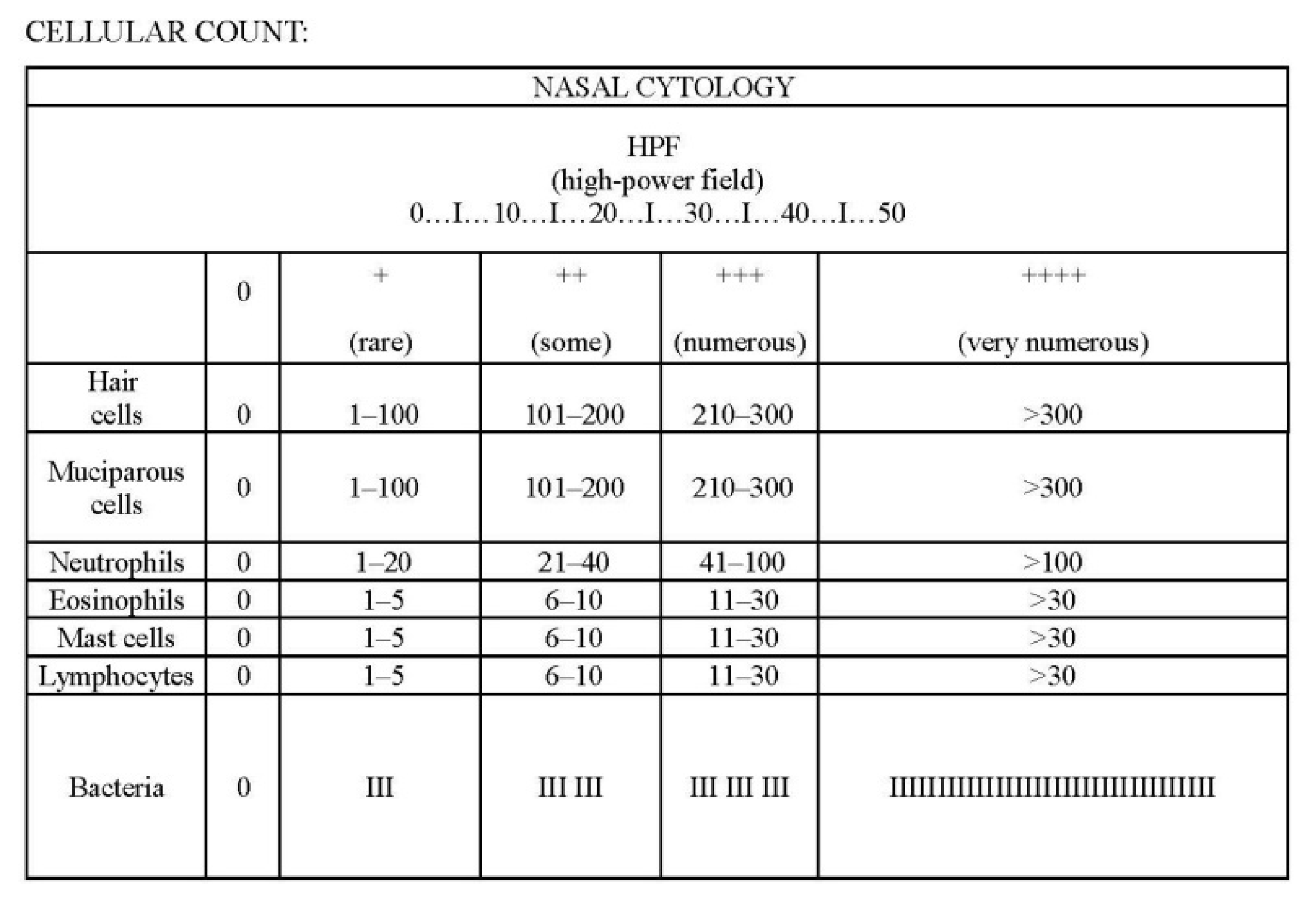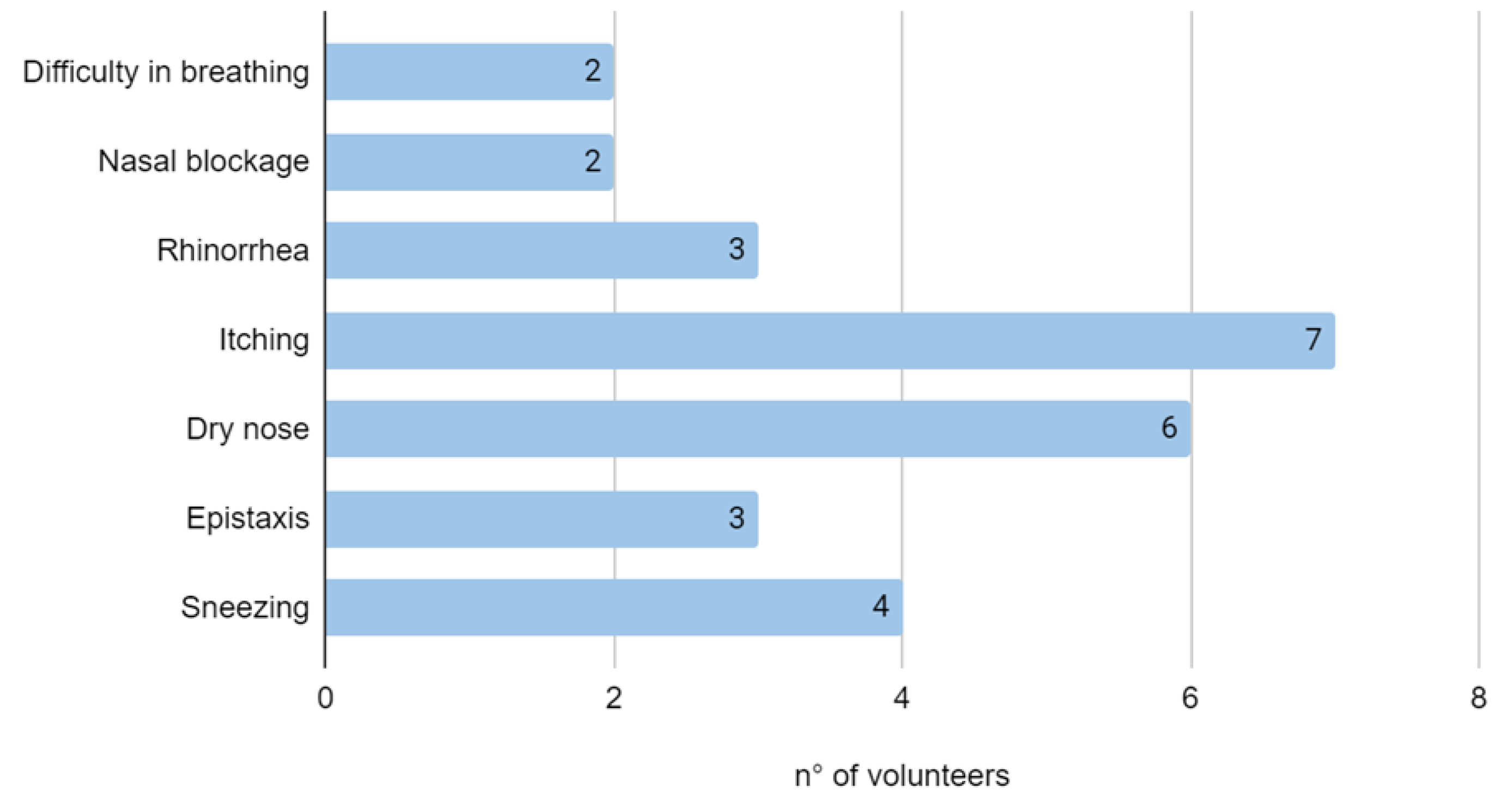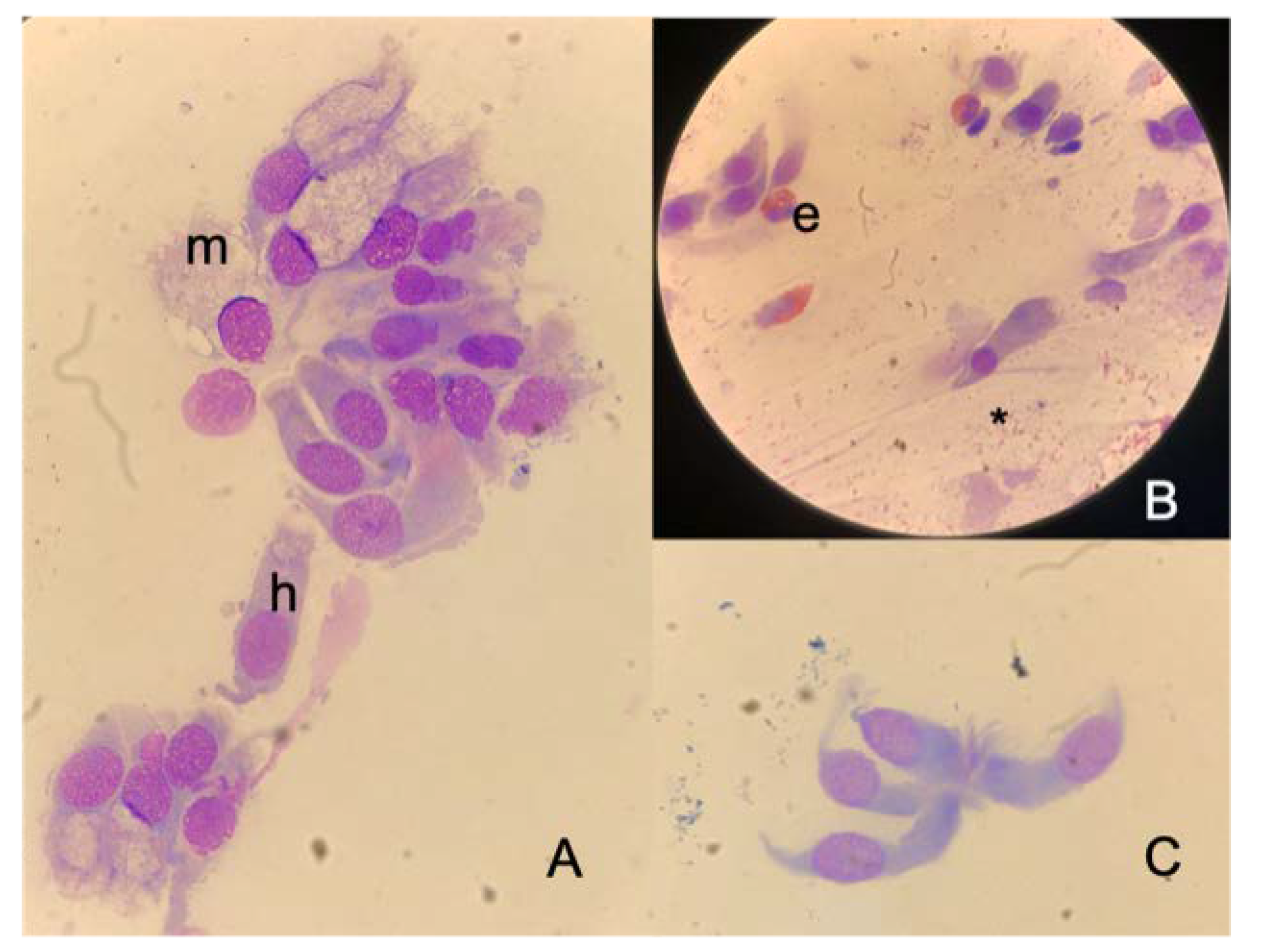Does Prolonged FFP2 Mask Use Cause Changes in Nasal Cytology? A Pilot Observational Study on Healthcare Workers
Abstract
1. Introduction
2. Materials and Methods
- -
- Lymphocytes
- -
- Neutrophils
- -
- Eosinophils
- -
- Mast cells
- -
- Hair cells
- -
- Muciparous cells
3. Results
4. Discussion
5. Conclusions
Author Contributions
Funding
Institutional Review Board Statement
Informed Consent Statement
Data Availability Statement
Conflicts of Interest
References
- Campagnoli, M.; Cerasuolo, M.; Arena, G.; Toso, A.; Borello, G.; Garzaro, M.; VallEtti, P.A. Sudden sensorineural hearing loss (SSHL) diagnostic delay during COVID-19 pandemic: A single-center retrospective study. Otorhinolaryngology 2021, 71, 91–94. [Google Scholar] [CrossRef]
- Campagnoli, M.; Cerasuolo, M.; Renna, M.; Dell’Era, V.; Valletti, P.A.; Garzaro, M. ENT Referral From Emergency Department During COVID-19: A Single-Center Experience. Ear Nose Throat J. 2021; online ahead of print. [Google Scholar] [CrossRef] [PubMed]
- Silverberg, S.L.; Puchalski Ritchie, L.M.; Gobat, N.; Murthy, S. COVID-19 infection prevention and control procedures and institutional trust: Perceptions of Canadian intensive care and emergency department nurses. Can. J. Anesth. 2021, 68, 1165–1175. [Google Scholar] [CrossRef] [PubMed]
- Hemmer, C.J.; Hufert, F.; Siewert, S.; Reisinger, E. Protection From COVID-19—The Efficacy of Face Masks. Dtsch Arzteblatt Int. 2021, 118, 59–65. [Google Scholar] [CrossRef]
- Ayouni, I.; Maatoug, J.; Dhouib, W.; Zammit, N.; Ben Fredj, S.; Ghammam, R.; Ghannem, H. Effective public health measures to mitigate the spread of COVID-19: A systematic review. BMC Public Health 2021, 21, 1015. [Google Scholar] [CrossRef]
- Dell’Era, V.; Aluffi Valletti, P.; Garzaro, M. Nasal Pressure Injuries During the COVID-19 Epidemic. Ear Nose Throat J. 2020, 99, 567–568. [Google Scholar] [CrossRef]
- Kyung, S.Y.; Kim, Y.; Hwang, H.; Park, J.W.; Jeong, S.H. Risks of N95 Face Mask Use in Subjects With COPD. Respir. Care 2020, 65, 658–664. [Google Scholar] [CrossRef]
- Roberge, R.J.; Kim, J.H.; Benson, S.M. Absence of consequential changes in physiological, thermal and subjective responses from wearing a surgical mask. Respir. Physiol Neurobiol. 2012, 181, 29–35. [Google Scholar] [CrossRef]
- Roberge, R.J.; Kim, J.H.; Coca, A. Protective facemask impact on human thermoregulation: An overview. Ann. Occup. Hyg. 2012, 56, 102–112. [Google Scholar] [CrossRef]
- Scarano, A.; Inchingolo, F.; Lorusso, F. Facial Skin Temperature and Discomfort When Wearing Protective Face Masks: Thermal Infrared Imaging Evaluation and Hands Moving the Mask. Int. J. Environ. Res. Public Health 2020, 17, E4624. [Google Scholar] [CrossRef] [PubMed]
- Johnson, A.T. Respirator masks protect health but impact performance: A review. J. Biol. Eng. 2016, 10, 4. [Google Scholar] [CrossRef] [PubMed]
- Roberge, R.J.; Bayer, E.; Powell, J.B.; Coca, A.; Roberge, M.R.; Benson, S.M. Effect of exhaled moisture on breathing resistance of N95 filtering facepiece respirators. Ann. Occup. Hyg. 2010, 54, 671–677. [Google Scholar] [CrossRef]
- Gelardi, M.; Fiore, V.; Giancaspro, R.; La Gatta, E.; Fortunato, F.; Resta, O.; Carpagnano, G.E.; Santomasi, C.; Dimitri, M.; Foschino Barbaro, M.P.; et al. Surgical mask and N95 in healthcare workers of COVID-19 departments: Clinical and social aspects. Acta Bio-Medica Atenei Parm. 2020, 91, e2020171. [Google Scholar] [CrossRef]
- Klimek, L.; Huppertz, T.; Alali, A.; Spielhaupter, M.; Hörmann, K.; Matthias, C.; Hagemann, J. A new form of irritant rhinitis to filtering facepiece particle (FFP) masks (FFP2/N95/KN95 respirators) during COVID-19 pandemic. World Allergy Organ. J. 2020, 13, 100474. [Google Scholar] [CrossRef]
- Heffler, E.; Landi, M.; Caruso, C.; Fichera, S.; Gani, F.; Guida, G.; Liuzzo, M.T.; Pistorio, M.P.; Pizzimenti, S.; Riccio, A.M.; et al. Nasal cytology: Methodology with application to clinical practice and research. Clin. Exp. Allergy 2018, 48, 1092–1106. [Google Scholar] [CrossRef] [PubMed]
- Gelardi, M.; Iannuzzi, L.; Quaranta, N.; Landi, M.; Passalaqua, G. NASAL cytology: Practical aspects and clinical relevance. Clin. Exp. Allergy 2016, 46, 785–792. [Google Scholar] [CrossRef]
- Navarro-Triviño, F.J.; Merida-Fernández, C.; Ródenas-Herranz, T.; Ruiz-Villaverde, R. Allergic contact dermatitis caused by elastic bands from FFP2 mask. Contact. Dermat. 2020, 83, 168–169. [Google Scholar] [CrossRef]
- Kisielinski, K.; Giboni, P.; Prescher, A.; Klosterhalfen, B.; Graessel, D.; Funken, S.; Kempski, O.; Hirsch, O. Is a Mask That Covers the Mouth and Nose Free from Undesirable Side Effects in Everyday Use and Free of Potential Hazards? Int. J. Environ. Res. Public Health 2021, 18, 4344. [Google Scholar] [CrossRef] [PubMed]
- Battista, R.A.; Ferraro, M.; Piccioni, L.O.; Malzanni, G.E.; Bussi, M. Personal Protective Equipment (PPE) in COVID-19 Pandemic: Related Symptoms and Adverse Reactions in Healthcare Workers and General Population. J. Occup. Environ. Med. 2021, 63, e80–e85. [Google Scholar] [CrossRef]
- Carbon, C.C. About the Acceptance of Wearing Face Masks in Times of a Pandemic. Iperception 2021, 12, 20416695211021114. [Google Scholar] [CrossRef]
- Carragher, D.J.; Hancock, P.J.B. Surgical face masks impair human face matching performance for familiar and unfamiliar faces. Cogn. Res. Princ. Implic. 2020, 5, 59. [Google Scholar] [CrossRef] [PubMed]
- Marler, H.; Ditton, A. “I’m smiling back at you”: Exploring the impact of mask wearing on communication in healthcare. Int. J. Lang. Commun. Disord. 2021, 56, 205–214. [Google Scholar] [CrossRef] [PubMed]
- Malzanni, G.E.; Canova, C.; Battista, R.A.; Malerba, P.; Lerda, C.; Angelone, S.M.; Bussi, M.; Piccioni, L.O. Restrictive measures during COVID-19 pandemic: The impact of face masks and social distancing on communication, physical and mental health of normal hearing subjects. Hear. Balance Commun. 2021, 19, 144–150. [Google Scholar] [CrossRef]



| Patient | Time of Observation | Eosinophils | Mast Cells | Neutrophils | Lymphocytes | Bacteria | Muciparous Cells | Hair Cells |
|---|---|---|---|---|---|---|---|---|
| 1 | T0 | 0 | 0 | 0 | 0 | 0 | ++ | +++ |
| T1 | 0 | 0 | 0 | 0 | 0 | ++ | +++ | |
| 2 | T0 | 0 | 0 | 0 | 0 | 0 | ++ | ++ |
| T1 | 0 | 0 | 0 | 0 | 0 | ++ | ++ | |
| 3 | T0 | 0 | 0 | 0 | 0 | 0 | ++ | +++ |
| T1 | 0 | 0 | 0 | 0 | 0 | ++ | +++ | |
| 4 | T0 | + | 0 | + | 0 | 0 | +++ | ++ |
| T1 | + | 0 | + | 0 | 0 | +++ | ++ | |
| 5 | T0 | 0 | 0 | 0 | 0 | 0 | +++ | ++ |
| T1 | 0 | 0 | 0 | 0 | 0 | +++ | ++ | |
| 6 | T0 | 0 | 0 | 0 | 0 | 0 | +++ | +++ |
| T1 | 0 | 0 | 0 | 0 | 0 | +++ | +++ | |
| 7 | T0 | ++ | + | + | 0 | 0 | + | ++ |
| T1 | ++ | + | + | 0 | 0 | + | ++ | |
| 8 | T0 | 0 | 0 | + | 0 | 0 | ++ | +++ |
| T1 | 0 | 0 | + | 0 | 0 | ++ | +++ | |
| 9 | T0 | ++ | 0 | 0 | 0 | 0 | + | + |
| T1 | ++ | 0 | 0 | 0 | 0 | + | + | |
| 10 | T0 | 0 | 0 | 0 | 0 | 0 | ++ | ++ |
| T1 | 0 | 0 | 0 | 0 | 0 | ++ | ++ |
Publisher’s Note: MDPI stays neutral with regard to jurisdictional claims in published maps and institutional affiliations. |
© 2022 by the authors. Licensee MDPI, Basel, Switzerland. This article is an open access article distributed under the terms and conditions of the Creative Commons Attribution (CC BY) license (https://creativecommons.org/licenses/by/4.0/).
Share and Cite
Campagnoli, M.; Dell’Era, V.; Rosa, M.S.; Aluffi Valletti, P.; Garzaro, M. Does Prolonged FFP2 Mask Use Cause Changes in Nasal Cytology? A Pilot Observational Study on Healthcare Workers. Healthcare 2022, 10, 2365. https://doi.org/10.3390/healthcare10122365
Campagnoli M, Dell’Era V, Rosa MS, Aluffi Valletti P, Garzaro M. Does Prolonged FFP2 Mask Use Cause Changes in Nasal Cytology? A Pilot Observational Study on Healthcare Workers. Healthcare. 2022; 10(12):2365. https://doi.org/10.3390/healthcare10122365
Chicago/Turabian StyleCampagnoli, Massimo, Valeria Dell’Era, Maria Silvia Rosa, Paolo Aluffi Valletti, and Massimiliano Garzaro. 2022. "Does Prolonged FFP2 Mask Use Cause Changes in Nasal Cytology? A Pilot Observational Study on Healthcare Workers" Healthcare 10, no. 12: 2365. https://doi.org/10.3390/healthcare10122365
APA StyleCampagnoli, M., Dell’Era, V., Rosa, M. S., Aluffi Valletti, P., & Garzaro, M. (2022). Does Prolonged FFP2 Mask Use Cause Changes in Nasal Cytology? A Pilot Observational Study on Healthcare Workers. Healthcare, 10(12), 2365. https://doi.org/10.3390/healthcare10122365









